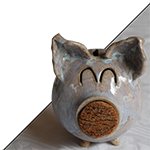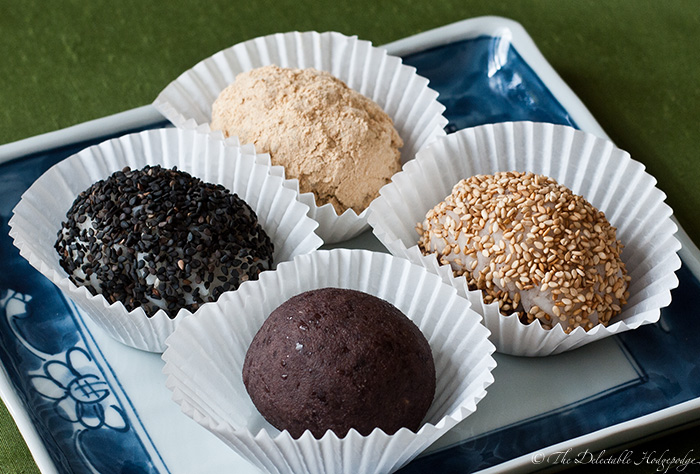
Ohagi
| Ingredient | 6 Koshian | 6 Koshian | 6 Kinako or Sesame | 6 Kinako or Sesame |
|---|---|---|---|---|
| koshian | 9 oz. | 250g | 5.5 oz. | 150g |
| sweet (mochi) rice | 3.5 oz. | 100g | 3.5 oz. | 100g |
| water | 5.5 oz. | 160ml | 5.5 oz. | 160ml |
| kinako | none | none | to coat | to coat |
| sesame seeds | none | none | to coat | to coat |
Ohagi are one of the myriad ball-shaped combinations of anko and sweet rice found among traditional Japanese desserts. Heartier and more assertive on the teeth than some of their relatives, ohagi can stand in as either a sweet-yet-substantive snack to those so inclined, or a mildly-sweet dessert.
Simple ohagi consist of a ball of coarse sweet rice surrounded by a layer of sweet anko bean paste. Another type of ohagi are inverted, with the rice on the outside and beans on the inside; these are coated with a layer of sesame seeds or kinako, a type of soy flour.
Preparation
- Prepare a batch of koshian for the filling; freeze any you don’t end up using.
- Divide the bean paste into six balls and set them aside.
- Wash the rice, drain it fully, then in a microwaveable bowl add 160ml (5.5 oz.) water to the rice and let it sit for one hour.
Directions
Koshian Ohagi
- Cover and microwave.
After it has soaked for an hour, cover the rice with plastic wrap and microwave on high for about 4 minutes (longer if you have a weak microwave). Remove the plastic wrap and microwave for 1 minute. - Pound the rice.
Using a pestle or a similar blunt object, pound the rice with an up-and-down gesture until it has partly turned into a mass, but individual rice grains are still visible. You can pound it less or more if you prefer softer or stickier rice, respectively. - Form into a cylinder.
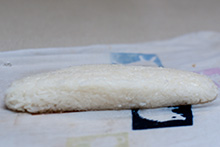 Wet a cloth and wring it thoroughly, then drop the rice into it and use the cloth to roll the rice into a cylinder.
Wet a cloth and wring it thoroughly, then drop the rice into it and use the cloth to roll the rice into a cylinder.
- Divide into six balls.
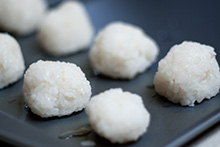 Unwrap the rice, slice it into six equal pieces, and roll them into slightly elongated, egg-shaped balls.
Unwrap the rice, slice it into six equal pieces, and roll them into slightly elongated, egg-shaped balls.
- Shape koshian.
Press each ball of koshian between your palms to flatten it into a disk a little bigger than the balls of rice; the edges can be thinner than the middle. - Wrap balls of rice.
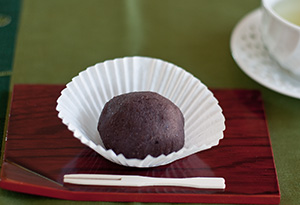 Lay each ball of rice horizontally (that is, with the pointier ends to the sides) onto a koshian disk, then work the beans around it with your fingers until the rice is almost completely covered; leave it so that a little bit of rice is still visible — this will be the bottom. Again, the pointy ends of the oval will be the sides, not the top and bottom, of the finished ohagi.
Lay each ball of rice horizontally (that is, with the pointier ends to the sides) onto a koshian disk, then work the beans around it with your fingers until the rice is almost completely covered; leave it so that a little bit of rice is still visible — this will be the bottom. Again, the pointy ends of the oval will be the sides, not the top and bottom, of the finished ohagi.
Kinako Ohagi
- Prepare inverted ohagi.
Prepare the balls exactly as with koshian ohagi, with the rice and koshian switched (and a smaller amount of koshian), so that the balls end up with koshian on the inside and a coating of rice on the outside. Wet your hands when working with the rice so that it doesn’t stick. - Finish with kinako.
Dry your hands and put a generous layer of kinako on a plate, then roll the balls gently in it until they are thoroughly coated.
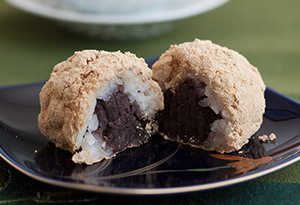
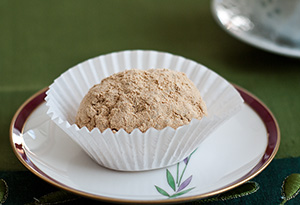
Sesame Ohagi
- Prepare inverted ohagi.
Prepare the balls exactly as with koshian ohagi, with the rice and koshian switched (and a smaller amount of koshian), so that the balls end up with koshian on the inside and a coating of rice on the outside. Wet your hands when working with the rice so that it doesn’t stick. - Finish with sesame seeds.
Dry your hands and put a generous layer of sesame seeds — white or black — on a plate, then roll the balls gently in the seeds until they have an even coating.
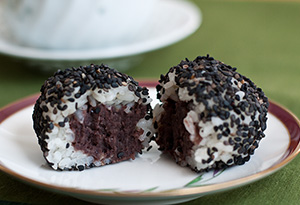
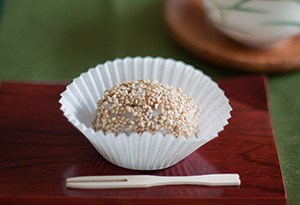
Notes
- Kinako is somewhat different from the soy flour commonly sold in the US. Standard soy flour is made up of either whole ground soybeans or defatted ground soy beans (in the case of flour intended for use as a protein source). Kinako is made from whole roasted soy beans ground very finely; it has a more complex flavor and darker color.
- If you can’t find kinako, you can roast regular soy flour to get close enough to make a good substitute. Put the soy flour in a small uncoated pan and cook over low heat, stirring constantly, until it starts to get a little darker. Be careful; it’s easy to burn.

